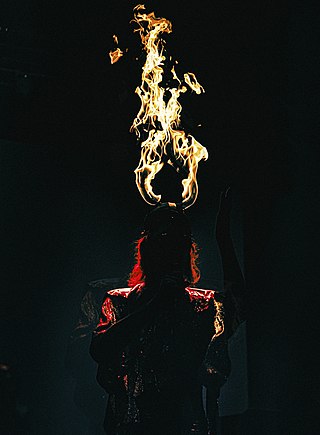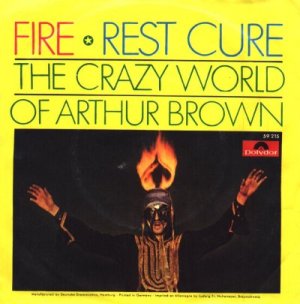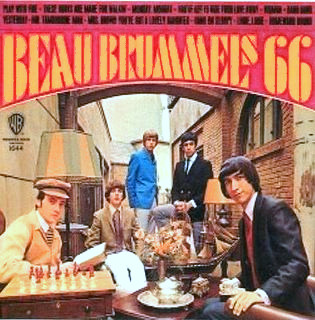
Arthur Wilton Brown is an English singer and songwriter best known for his flamboyant and theatrical performances, eclectic work and his powerful, wide-ranging operatic voice, in particular his high pitched banshee screams. He is also notable for his unique stage persona, featuring extreme facepaint and a burning helmet.

The Crazy World of Arthur Brown is the debut studio album by the English rock band the Crazy World of Arthur Brown. Released in the United Kingdom in June 1968 by Track Records and in the United States in September 1968 through Atlantic, the album was an international success, propelled by the transatlantic hit single "Fire". It was the only album released during the Crazy World's original incarnation.

Vincent Rodney Cheesman, known professionally as Vincent Crane, was an English keyboardist, best known as the organist for the Crazy World of Arthur Brown and Atomic Rooster. Crane co-wrote "Fire", the 1968 hit single by the Crazy World of Arthur Brown.

Carl Frederick Kendall Palmer is an English drummer best known as a founding member of the supergroups Emerson, Lake & Palmer, Asia and sometimes Acoustic Alchemy. He has toured with his own bands since 2001, including Palmer, the Carl Palmer Band, and currently, Carl Palmer's ELP Legacy. He previously was a touring drummer for The Crazy World of Arthur Brown and a founding member of Atomic Rooster.
Kingdom Come were a British rock band fronted by Arthur Brown. The band was recognized for Brown's theatrical and operatic singing, and a sound that drew from psychedelic and progressive rock. This combination made the band a hit on Britain's festival circuit, but lack of record sales, indifference from music critics, and poor record label promotion led to its eventual demise in 1974.
Track Record was founded in 1966 in London by Kit Lambert and Chris Stamp, then managers of the rock group The Who. It was one of the first British-owned independent record labels in the United Kingdom. The most successful artists whose work appeared on the Track label were The Jimi Hendrix Experience, The Who, The Crazy World of Arthur Brown, Thunderclap Newman and Golden Earring. The label ceased operations in 1978 but was revived in 1999.

"Rosalyn" is the debut single by British rock band Pretty Things, released in 1964. It charted at number 41 in the United Kingdom.

"Fire" is a 1968 song written by Arthur Brown, Vincent Crane, Mike Finesilver and Peter Ker. Performed by the Crazy World of Arthur Brown, it was released as a single and on the band's debut album, also called The Crazy World of Arthur Brown. The single became a transatlantic hit, reaching number one in the UK and Canada and number two in the United States, while hitting the top 10 in markets across Europe.

Randy Holden is an American guitarist best known for his membership of the West Coast acid rock group Blue Cheer and performance on their third album, New! Improved! (1969). His solo album Population II (1970) is considered to be one of the earliest examples of doom metal. Holden is also a painter.

Atomic Rooster are a British rock band originally formed by members of The Crazy World of Arthur Brown, organist Vincent Crane and drummer Carl Palmer. Their history is defined by two periods: the early-mid-1970s and the early 1980s. The band went through radical style changes, but they are best known for the hard, progressive rock sound of their hit singles, "Tomorrow Night" and "Devil's Answer", both in 1971.
The Other Half was an American psychedelic garage rock band, based in San Francisco, and active in the mid-to-late 1960s. The band gained interest after one of the Nuggets compilations in the 1980s included their single, "Mr. Pharmacist".

"You Tell Me Why" is a song by American rock group The Beau Brummels, from the band's second album, The Beau Brummels, Volume 2. The song was written by guitarist Ron Elliott and produced by Sylvester Stewart, later known as Sly Stone. "You Tell Me Why" was released as the album's lead single, and peaked at number 38 on the Billboard Hot 100 in August 1965. The band revisited the song and included it on their 1975 eponymous album. The original version later appeared on the band's 1987 compilation album The Best of The Beau Brummels 1964–1968.

"Just a Little" is a song by the American rock group the Beau Brummels. The song is included on the band's debut album, Introducing the Beau Brummels, and was released as its second single, following "Laugh, Laugh". "Just a Little" became the band's best hit parade U.S. single, which peaked at number eight on the Billboard Hot 100 in June 1965. It also reached no lower than position #10 of the hit parades in Canada and Australia.

Bradley's Barn is the fifth studio album by the American rock group the Beau Brummels. Released in October 1968, it contains the singles "Long Walking Down to Misery" and "Cherokee Girl." The album has received critical acclaim as an early example of country rock. Bradley's Barn is actually a recording studio in Nashville owned by Owen Bradley.

The Beau Brummels were an American rock band that formed in 1964 and originally consisted of singer Sal Valentino, lead guitarist Ron Elliott, bassist Ron Meagher, rhythm guitarist Declan Mulligan and drummer John Petersen. Local radio disc jockeys Tom Donahue and Bobby Mitchell discovered the band at a club near San Francisco. They signed the Beau Brummels to their fledgling Autumn Records label, and their house producer, Sylvester Stewart, later known as Sly Stone, recorded the band's early sessions.
"Good Time Music" is a song originally recorded by the American folk-rock band the Lovin' Spoonful in 1965. Written by John Sebastian, it appeared on the 1966 Elektra Records compilation What's Shakin'. Author Richie Unterberger characterizes the song as "a sort of manifesto of the group's optimism in its jaunty rhythms and celebration of the return of good time music to the radio."

Beau Brummels '66 is the third studio album by the American rock group the Beau Brummels, and their first on Warner Bros. Records. The album consists of twelve cover songs and no originals. Autumn Records, the band's previous label, had sold the band to Warner Brothers in early 1966. Warner Brothers, however, did not control the publishing rights, and opted to have the band record an album of covers, including songs originally performed by The Beatles and Bob Dylan, as well as recent hit singles by such acts as The Mamas & the Papas and Simon & Garfunkel. Lead vocalist Sal Valentino explained, "When we went to Warner Brothers, they were just anxious to get a record out, to capitalize on the success we had. That record was the wrong one to do at the time."
"Magic Hollow" is a song by American rock group The Beau Brummels, from the band's fourth album, 1967's Triangle. The song, written by guitarist Ron Elliott and lead singer Sal Valentino, was released as the album's first single. The song appeared on the band's 1987 compilation album The Best of the Beau Brummels 1964-1968, and "Magic Hollow" also served as the title of the band's 2005 four-disc box set.

The Beau Brummels is the sixth studio album by the American rock band of the same name. Released in April 1975, the album features the work of all five original band members for the first time since the band's debut album, 1965's Introducing the Beau Brummels. The album peaked at number 180 on the U.S. Billboard 200 albums chart in 1975.

"Get Me to the World on Time" is a song written by Annette Tucker and Jill Jones for the American garage rock band, The Electric Prunes. The song was released in March 1967 following the success of the band's previous single, "I Had Too Much to Dream ". Although the follow-up did not have the same success, "Get Me to the World on Time" still charted at number 27 on the Billboard Hot 100. The single also fared slightly better in the UK, where it reached number 42.
















